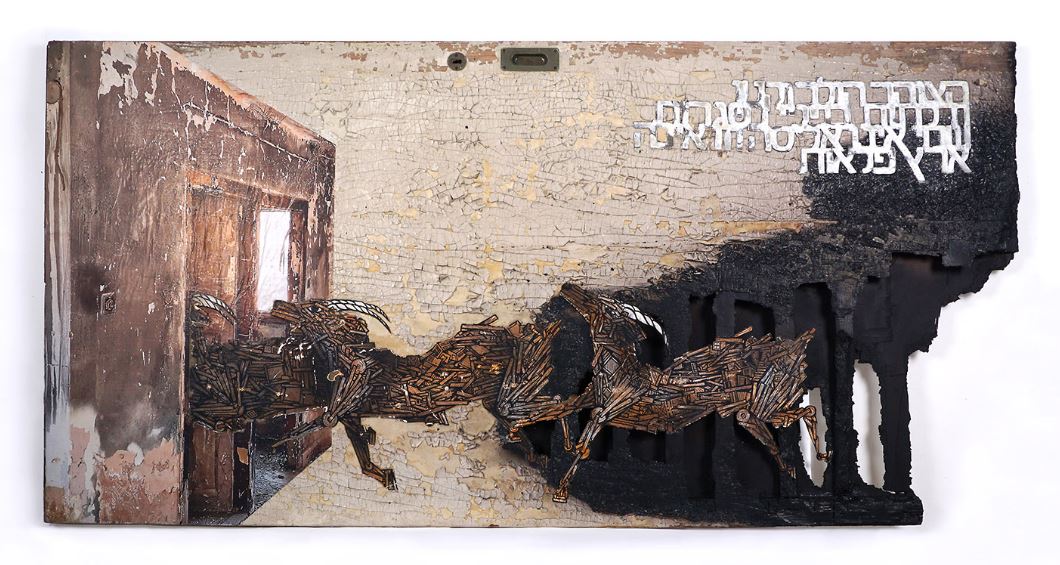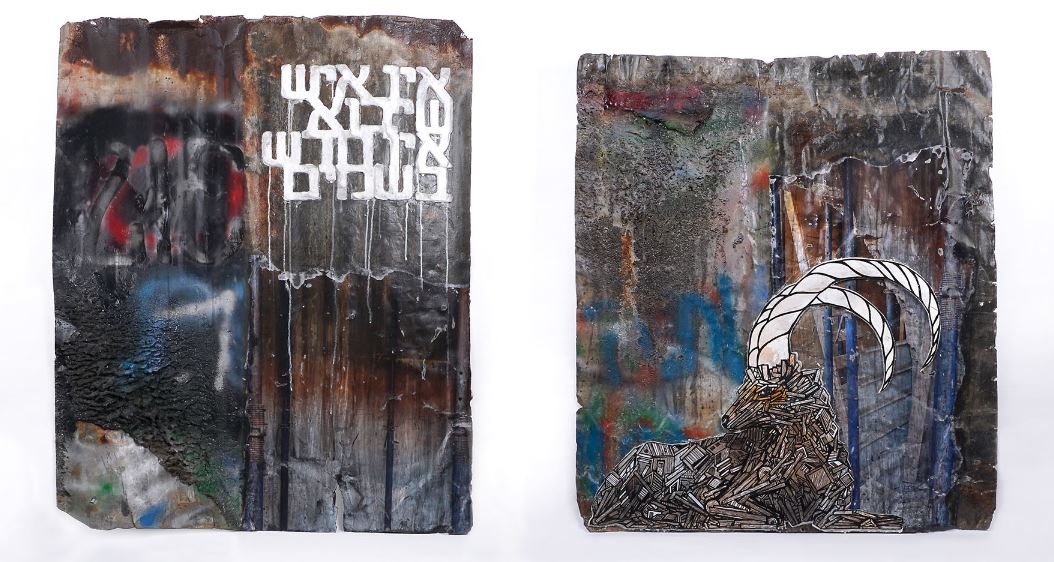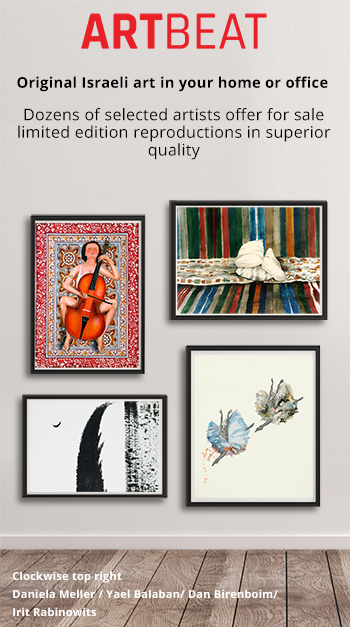Art Shows > Dede & Nitzan Mintz - Non-Destructive
Dede & Nitzan Mintz - Non-Destructive / Zemack Contemporary Artטלפון - 972 3 6915060 04/04/2019 to - 17/05/2019 Dede & Nitzan Mintz ‘Non-Destructive’
Curator: Hagar Bril The places that inspired the new exhibition by Dede and Nitzan Mintz cannot be seen today. During the last year, leading up to the exhibition, the artists roamed through old buildings scheduled for demolition all around Tel Aviv. They made their way into ruins, some of which had been closed for decades, and some that had recently been locked: Beit Shlush, Beit HaRav Kook, Ishmaeloff Hotel on the corner of Yavne St. and Montefiore St., the house on Engel 9, Rothschild 12 and others. All of which are located in the heart of the city's most central and desirable neighbourhoods, neighbourhoods that have undergone gentrification and accelerated price increases years ago, which gradually pushed out their residents in favour of luxury towers and boutique hotels. These places were the last vestiges of an old city, buildings that remained empty due to a conflict between residents or inheritance struggles, and served as architectural monuments. With the opening of the exhibition today, all these structures are in various processes of renovation, preservation, demolition or reconstruction. Some of them were completely shut and sealed, some surrounded by scaffolding and fences, others were demolished to the foundations and rebuilt to become another architectural gem that would help, elegantly, to move the residents to other places. From these neglected buildings, Dede and Nitzan Mintz collected pieces of life: doors, windows, kitchen shelves, wood and plastic coverings, metal plates, wallpaper and cabinet parts. Alongside the physical act of collection, historical research was also carried out: from rummaging into buildings’ files in the municipal archives, through conversations with the local residents, to stories sent to them through social networks; the artists collected every possible piece of information about the buildings they visited. As in a rescue operation, each of the objects that they chose to gather from the building bore a story, a memory and a historical significance that the artists saw right to save and preserve from the rubble. Each of them served as a platform for Dede's wooden animal paintings and the lyrics of Mintz's poems, which themselves are an inseparable part of Tel Aviv's urban landscape. The different techniques of the artists are deliberately resonating with the construction world: industrial paints, strong adhesives, plaster and cement mixtures. For each of the items, a work method was chosen to suit their unique character. Thus, in one work, a cover of electrical channels that was damaged in a fire went through another fire in the studio, while in a different work a synthetic mixture accelerates processes of distortion, swelling and dismantling a curved tin surface covered with rust. The artists seek to preserve the history of each of the objects they saved from the destroyed buildings, and to this end they decided to preserve their original color, and almost not to cover up the scraps, textures, tatters or previous graffiti on their surfaces. If and when they decided to paint, the colors were chosen to correspond with the original color of the doors, gates and shelves taken from the building. Sometimes additional elements appear in the works, such as old scraps of wallpaper, elevator buttons and electrical outlets. The direct connection between the object and its original location is also preserved by using photographs: While wandering around the destroyed buildings, Dede and Nitzan Mintz documented the desolate spaces, the crumbling walls and the neglected courtyards surrounding them. Some of these photos have been reprinted and repasted onto the objects, which now carry with them a visual reminder of the space that once contained them. In other cases, the photographs became stencil outlines. Thus, the original building environment reverberates its existence on the wood and metal surfaces by means of an image of wire coils that enclose the place, a panoramic view of a nearby construction site, an unkempt palm tree or wild-looking thistles in the yard. Indeed, the motif of vegetation grows and returns in many works in the exhibition: whether in the silhouette of the ricinus plant, in the silhouette of thistles or in the palm tree that no one has cared for in decades. The dense and wild vegetation is the first outward sign of the abandonment: no one bothers to cultivate the garden surrounding the house, and nature finds its way to go feral, emerge from the cracks, and take control of man's work. The course of action taken by the artists is one that seeks to preserve the original materials they found, without altering their nature, shape and characteristics. In this way, non-destructive tests, which gave the exhibition its title, are also carried out. Non-destructive tests exist in the field of construction as well as in medicine and even art, and they constitute a complex of review and testing technologies that do not materially alter the object of the test. For example, sound waves are used to detect changes in the density of building materials, or unabsorbed fluids are inserted into different surfaces to detect and mark cracks. Dede and Nitzan's unique work process, which preserves and perpetuates the existence of these old houses, opens up questions and queries about the urban environment that was - and is not. The use of objects found in abandoned buildings raises thoughts about the historical urban space, about the rapid and drastic changes that this space goes through, and about the social, political and economic implications that accompany these changes. This is an attempt to preserve the memory of a place that was once a home - both in the literal and the metaphoric sense, the memory of a childhood landscape and a familiar and inviting environment. Dede and Nitzan Mintz work all over the world, but were born and raised in Tel Aviv and live there today. As residents of the Tel Aviv, who see it as their home, the scale and the dizzying pace of the architectural changes that pass through it gradually unravel their sense of belonging and local identity, like that of many others living in the city. Domestic familiarity is often undermined by these changes - and sometimes even replaced by a sense of exclusion, detachment and alienation from a home that once existed. The familiar images of Dede, decorating all those inner parts of the houses, also express the same feelings of confinement and flight: a wooden bird whose wings are burnt at the edges and is unable to fly, a pair of ibex who are battling against each other as they fight for a shrinking territory, closing on them from all directions. In addition to the wooden animals, the works also include silhouettes of the ricinus – that is toxic to human consumption, which erupts in places where neglect has struck. This is the same plant that God gives to the prophet Jonah, who lives outside of Nineveh to save him, but takes it away in a trice to teach him a lesson. What was, is not necessarily what will be. Together with these images are poems by Nitzan Mintz, which deal with similar sensations: her lyrics describe a perpetual state of struggle, an attempt to take part in a constantly changing place and society, racing forward without restraint. The urban environment, as well as the human one, are described in the poems as operating in a kind of oiled, multi-gear machine with doors being shut in our faces. Everyone seems to be in constant pursuit, in a perpetual hunger that is never satisfied, in an endless effort to meet unclear goals and to remain part of that Wonderland - which is not a wonderland at all. location - Zemack Contemporary Art Time - 04/04/2019 to - 17/05/2019 Exhibition opening - 04/04/2019, שעה - 20:00 |
The content appearing on this page and the details of this exhibition are shown on the behalf of the advertisers and on their responsibility.
All rights reserved to - artbeat.co.il © Israel Art
|1|



